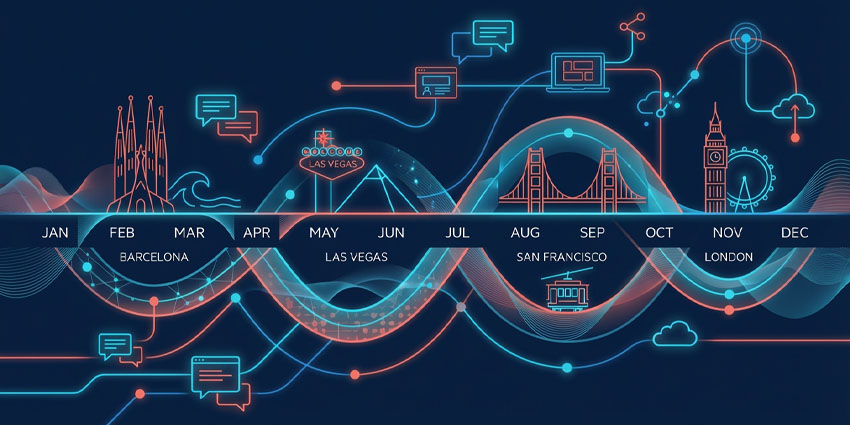The world of work is changing.
Working as a team doesn’t just mean meeting your colleagues in a board room and making notes on a whiteboard. Connecting with other colleagues now involves everything from video conferencing, to instant messaging and huddle rooms.
As work becomes more “something we do” than a place we go, the tools we use for better collaboration are evolving. We’re discovering new ways that we can work together, breaking down walls like distance and access to technology.
Collaboration in the new age is a concept consisting of various powerful elements, from team collaboration tools like Microsoft Teams and Slack to VCaaS and room kits.
Now that 83% of professionals say that they rely on technology for true collaboration, what does it mean to create a modern, collaborative business?
Here’s your introduction to collaboration as it is today.
What is Collaboration?
Collaboration isn’t a new concept. Ever business since the dawn of time has relied on its workers to combine their skills and work cohesively towards shared goals. Collaboration, at a fundamental level, is all about excellent teamwork.
However, as the workplace has changed, the tools that we use for collaboration are evolving too. Today’s employees aren’t just reliant on things like phone calls and audio conferences to make connections. Instead, we have access to a new era of collaborative tools.
Collaboration and communication go hand-in-hand. You can’t have good collaboration without a good communication stack. Because of this, many collaborative tools build on the systems that we use to connect each day, like video conferencing services, and web-based software.
However, the term “collaboration tool” also applies to other solutions that can help employees to work more effectively together. For instance, room kits that support group meetings with internal and external staff are a type of collaboration tool. Workforce management tools that track employee productivity and assign tasks help teams to collaborate too.
Here are some of the most common tools that fall under the “collaboration” umbrella:
- Team collaboration tools: Software like Microsoft Teams, Slack, RingCentral Glip, and Avaya Spaces all deliver a handful of tools for better teamwork. These tools support constant, real-time messaging, as well as file and screen sharing, video conferencing, and more. Team collaboration tools essentially deliver an all-in-one environment for collaboration.
- Video conferencing: Video conferencing is an essential component at the heart of collaboration. With video meetings, employees can have intimate and contextual conversations with team members wherever they are. Video is becoming increasingly valuable in the age of remote working. VCaaS, or video conferencing as a service, unlocks all the tools teams need for video meetings over the cloud.
- Room kits and devices: Hardware can contribute to collaboration too. Room kits that allow teams to set up a huddle room for video meetings in an instant are crucial to good collaboration. We also have tools like wide-field video cameras, and intelligent conference phones to consider. You might even add something like a virtual whiteboard to your collaboration tool stack.
- Schedule management and productivity: Tools for productivity are another must-have in the new collaboration world. These systems allow business leaders to assign tasks, track progress, and set deadlines. You can even use your management tools to assess the performance of employees and see which of your team members are driving the best results for your business.
- Headsets: Headsets offer an excellent combination of features to boost collaboration. Some systems can even change your status on team collaboration tool when you enable a busy-light. At the same time, headsets make it easier for employees to connect with their colleagues wherever they are, through mobile apps and cloud-based tools.
In the new, digital world, everything from your headset to your mobile phone can be a crucial part of your collaboration experience.
Collaboration Trends
The trends emerging in collaboration come from the increasingly evident needs of a changing workforce. For instance, as companies discovered that they could save time and money by making conference rooms smaller, teams began to replace large board rooms with smaller, huddle room spaces. Complicated processes for setting up video conferencing and meeting rooms are becoming a thing of the past.
Video conferencing technology is available through the cloud through VCaaS providers. This is an ideal solution for companies that just want to embrace the benefits of video for their team. At the same time, room kits bundle all of the hardware you need for a video session into an easy plug-and-play solution. As the market for video conferencing accelerates to a value of £9.34 billion, demand for these solutions will continue to grow.
Some of the most exciting collaboration trends include:
- All-in-one UC and Collaboration: Many team collaboration software providers are now going beyond just offering messaging and file sharing. By working with other companies, or creating their own tools, team collaboration companies are beginning to offer things like VCaaS, and UCaaS too. Microsoft has direct routing for Teams, for instance, while Zoom is building on Zoom phones.
- Plug and play room kits: As remote and mobile working becomes more popular; teams need a way to plug in a conferencing system and start a meeting instantly. Today’s collaboration tool providers are serving that need. Room kits for huddle rooms offer everything that teams need to immediately launch an effective meeting from any room. Wide-angle cameras and beamforming microphones mean that any office can become a meeting room in seconds.
- Intelligent assistants: Intelligent assistants are also making their way into the collaborative environment. With cognitive collaboration services, employees can learn about the other participants in a meeting before the conversation begins, reducing the need for small-talk. At the same time, virtual assistants that respond to voice can set up meetings or start recordings instantly.
- Video first collaboration: Video is quickly becoming the heart of the collaboration environment, rather than just an afterthought. We’re moving into a future where it will feel 100% natural to jump into a call with your video on, rather than just relying on voice. In the years to come, technology like 5G and 4K video will make these visual experiences even more exciting for modern workers.
- Intelligent hardware: Hardware equipped with tools for AI and IoT performance are making the collaboration space more incredible. Today’s collaboration systems can automatically block out a person’s background to reduce distractions. Some cameras can detect writing on a whiteboard and place it in an area where it doesn’t draw attention away from a presenter.
Collaboration Vendors
For the leading vendors in the communication space, collaboration is a must-have addition to the technology stack. Companies searching for the right UC environment are realising that they need to have the right solution for both internal and external conversation. This is leading to a rise of more UCaaS services and CPaaS solutions embedded with collaboration capabilities.
At the same time, CCaaS and UCaaS are moving closer together, with more companies looking for ways to keep their agents and office workers connected, so that they can better serve customers. Ultimately, the collaboration vendor aims to improve the efficiency and productivity of a business by enhancing the way people work together. Already, studies prove that the right collaboration tools improve business productivity by up to 30%.
The challenge for today’s vendors will be figuring out how to combine collaboration tools with the rest of the technology their customers rely on. At the same time, leaders in this space need to find ways that they can make their tools and services as easy-to-use as possible. The adoption of collaboration tools is crucial to reduce the risk of shadow messaging and IT. However, vendors need to be careful not to compromise on security when they’re focusing on accessibility.
Check out our UC Today Awards page if you want to learn more about some of the market leaders that we have our eye on in the collaboration space. Alternatively, why not visit our Collaboration Market Guide page for some of the top contenders?
Collaboration Events
Because collaboration is becoming the heart of all business operations, the discussion about collaboration tools is now appearing in a wide selection of events. In the A/V event industry, you can learn about virtual whiteboards, room kits, and video tools that make meetings easier and more immersive. In the unified communication landscape, team collaboration features are becoming a standard offering, alongside things like call recording and management.
Collaboration also has a part to play in the CPaaS space, where companies are looking for ways to embed elements of collaborative tools, like real-time chat and video messaging into their existing services. Going forward, we’ll continue to see collaboration playing a crucial role in the events that guide us in our business investments.
Here at UC Today, we’ll be staying on the cutting edge of the latest events for you. Stick with us for reports on everything from the rise of huddle rooms and coworking spaces, to the evolution of APIs. Who knows, the future could even involve events discussing VR and AR headsets for team interactions. Visit our collaboration events page here.
Collaboration Reviews
Collaboration is a broad topic with a lot of areas to consider.
You might be looking for the perfect VCaaS solution to work with your new room kit, or you need a workforce management software solution to engage employees. To help you make the right decision, we have a series of collaboration reviews for you to explore.
These reviews cover things like:
- The leading team collaboration tools like Avaya Spaces or Microsoft Teams
- The plug-and-play room kits and meeting room technology of today and tomorrow
- Collaboration APIs and CPaaS solutions for flexible companies
- UCaaS services that come with added collaboration features
- Endpoints for collaboration, like cameras, microphones, and speakers
- The latest innovations in smart-speaker technology, IoT, and AI
- Explorations into the future of AR and VR headsets
- VCaaS technology providers and apps
Remember, when searching for the ideal collaboration solution, focus on the real-world requirements of your team. As new technology emerges in the communication landscape, disruptive systems will continue to appear. Already, we’re seeing the arrival of headphones that can automatically translate languages, and VR headsets designed for businesses.
The important thing here isn’t to rush into buying new technology because it’s exciting. Start by figuring out what kind of roadblocks are preventing your teams from being their most successful. Maybe you want to make sure that your remote employees feel just as engaged with your team as in-office workers through VCaaS. Perhaps you want a project management tool that you can use to keep track of assignments and deadlines.
Whatever you’re looking for, monitor the adoption levels of your team to see how well they respond to the new technology, and ask for feedback where you can. At the same time, try to prioritize end-to-end integration. The future of collaboration is bound to be in a single-pane-of-glass environment for productivity. Your tools need to work cohesively together.
Collaboration Comparisons
When you decide what kind of collaboration tools you need, you can begin to compare options from the leading providers. Here at UC Today, we have plenty of excellent comparisons of everything from room kits to team collaboration software.
Our comparisons assess some of the most important features of great collaboration tools to help you make more informed decisions. While you’re considering your options, remember to think about:
- Ease of use: Collaboration tools need to be easy to use. Whether it’s a video camera or a team collaboration app, if your choice isn’t simple, your employees won’t use it. Make sure that your entire workforce feels comfortable with the solutions you pick. It helps to work backward from the issues that your employees are facing and look for a tool that can provide the right solution.
- Integrations: As mentioned above, your team members won’t want to spend all of their time jumping from one app to another. Finding tools that work well with the solutions you already have is essential. Many VCaaS solutions today ensure you can use any endpoints you choose to access your software. At the same time, you can find collaboration apps that integrate with other leading tools, like CRM systems and ticketing applications.
- Security: Just because collaboration tools should be easy to use, doesn’t mean they can be easy to breach. Ensure that the right security strategies are in place to protect both your team and your business. This means considering everything from end-to-end encryption, to finding out where your video conferencing recordings go when you store them.
UC Today Smart Guides
Collaboration is a complicated term today. The definition continues to grow and shift with the arrival of new tools that help teams from all backgrounds to work better together. The most important thing to remember is that any collaboration solution you invest in needs to align your employees.
The collaboration market will reach a value of $8.5 billion by 2024, and the demand for new tools continues to grow with the rise of remote working and globalization. If you want to make sure you’re ahead of the curve, why not check out our smart guide library? The UC Today buyer’s guides cover everything you need to know about this space. From VCaaS and room kits to team collaboration apps, discover the benefits of collaboration today.







